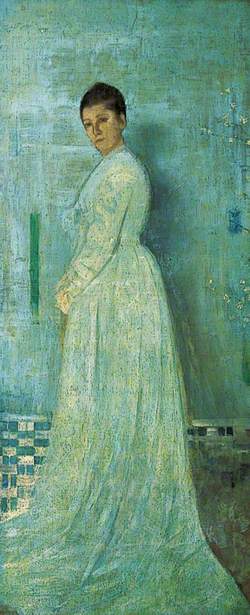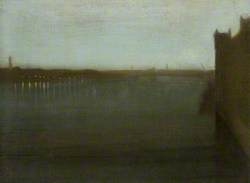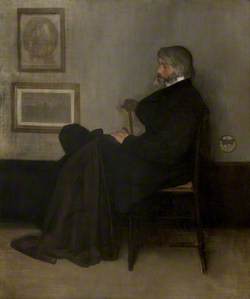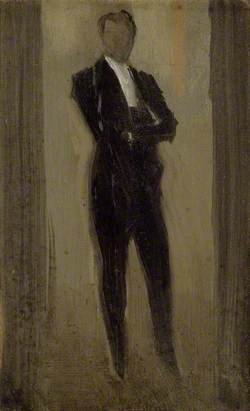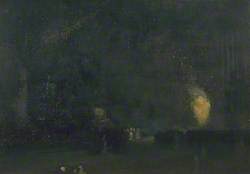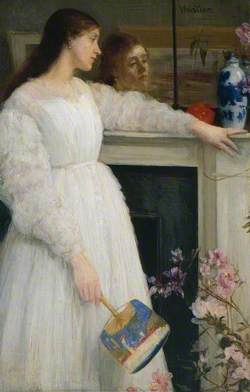How you can use this image
This image is available to be shared and re-used under the terms of the Creative Commons Attribution-NonCommercial-NoDerivatives licence (CC BY-NC-ND).
You can reproduce this image for non-commercial purposes and you are not able to change or modify it in any way.
Wherever you reproduce the image you must attribute the original creators (acknowledge the original artist(s) and the person/organisation that took the photograph of the work) and any other rights holders.
Review our guidance pages which explain how you can reuse images, how to credit an image and how to find more images in the public domain or with a Creative Commons licence available.
DownloadNotes
Add or edit a note on this artwork that only you can see. You can find notes again by going to the ‘Notes’ section of your account.
This picture was exhibited at the Royal Academy in 1865 as 'The Little White Girl'. It shows a young woman, dressed in white, leaning against a mantelpiece and gazing dreamily into a mirror. She is captured in a moment of deep contemplation. Her face is reflected in the mirror and silhouetted against a seascape, reinforcing the dream-like atmosphere. The reflected image is sad and careworn, and one is tempted to draw some kind of link with the wedding ring so prominently displayed on her left hand. Whistler may also have intended to evoke Velázquez's 'Rokeby Venus' (National Gallery, London), where the reflection of the woman's face is similarly at odds with her own idealised image. The poet Swinburne was so inspired by Whistler's picture that he composed a verse ballad, 'Before the Mirror', in response.
The model for the picture was Whistler's mistress, Jo Hiffernan, and the location the house that they shared in Lindsey Row, Chelsea. She is holding a Japanese fan of the type made for the European market. Whistler was fascinated by Japanese art and culture and collected Japanese objects from an early date. The fan, the red pot and blue and white vase on the mantelpiece, and the spray of pink azalea not only give the picture a Japanese feel, they provide brilliant colour notes against the neutral background of black, white and cream. Pictures hanging in the room are reflected in the mirror, their frames creating a series of right angles which are echoed by the fireplace and the mirror itself, dividing and compartmentalising the picture like a Japanese print.
In 1887 Whistler exhibited 'Symphony in White No. 3' (Barber Institute of Fine Arts, University of Birmingham). 'The Little White Girl' was accordingly given the additional title of 'Symphony in White, No. 2', in order to underline the importance of reading the picture as an arrangement of colours, and interpreting the mood rather the subject of the painting. Correspondingly, the first picture in the series, 'The White Girl' (1862, National Gallery of Art, Washington) became known as 'Symphony in White, No. 1'.
Further reading: Richard Dorment and Margaret F. MacDonald, 'James McNeill Whistler', exhibition catalogue, Tate Gallery, London 1994, pp.78–80, no.15, reproduced in colour p.79. Andrew Wilton and Robert Upstone (eds), 'The Age of Rossetti, Burne-Jones & Watts: Symbolism in Britain 1860–1910', exhibition catalogue, Tate Gallery, London 1997, pp.116–117, no.15, reproduced in colour p.116. Andrew McLaren Young, Margaret F. MacDonald, Robin Spencer with the assistance of Hamish Miles, 'The Paintings of James MacNeill Whistler', New Haven and London, 1980, no.52, reproduced in colour plate 31. Frances Fowle October 2000
Title
Symphony in White, No. 2: The Little White Girl
Date
1864
Medium
Oil on canvas
Measurements
H 76.5 x W 51.1 cm
Accession number
N03418
Acquisition method
Bequeathed by Arthur Studd 1919
Work type
Painting


